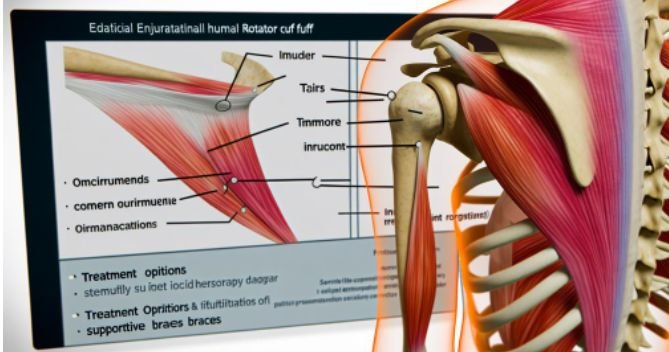When your shoulder starts feeling a bit under the weather, understanding the rotator cuff becomes essential. You might not realize it, but those four small muscles play a big role in keeping your shoulder stable and mobile. Injuries often come from repetitive motions, sudden trauma, or simply the passage of time. Recognizing the symptoms early and knowing your options for diagnosis and treatment can make all the difference. From non-surgical approaches to potential surgical interventions, the path to recovery is varied. So, how can you ensure the best outcome for your shoulder health?
Rotator Cuff Anatomy
The rotator cuff’s anatomy consists of four key muscles—supraspinatus, infraspinatus, teres minor, and subscapularis—that stabilize the shoulder joint. Each muscle has a unique role and attachment point on the scapula and humerus.
The supraspinatus, located at the top of the shoulder, initiates arm abduction. The infraspinatus and teres minor, positioned at the posterior aspect, facilitate external rotation of the arm. The subscapularis, found on the anterior surface, enables internal rotation.
Understanding the muscle structure is crucial because these muscles are intricately linked by tendons, which anchor them to the bones. Tendon function is vital; these tendons transmit the force generated by the muscles to the skeletal framework, ensuring smooth, coordinated movement.
The tendons converge to form a cuff around the humeral head, providing both stability and mobility to the shoulder joint.
When these tendons and muscles work harmoniously, they maintain the shoulder’s dynamic stability, allowing for a wide range of motion. However, any imbalance or injury can disrupt this delicate synergy, leading to impaired function. Knowing this anatomy helps you appreciate the complexity and importance of maintaining shoulder health.
Common Injury Causes
Understanding the intricate anatomy of the rotator cuff provides a foundation for recognizing the common causes of injuries, which often stem from repetitive motion, acute trauma, or degenerative changes in the tendons.
Repetitive overhead movements, frequently seen in sports injuries, place significant strain on the supraspinatus tendon, leading to microtears and inflammation. Athletes involved in swimming, tennis, or baseball are particularly susceptible due to the high demands on shoulder mobility and strength.
Acute trauma, such as falling on an outstretched arm or a sudden jerking motion, can cause immediate tears in the rotator cuff tendons. These injuries are common in contact sports and can result in partial or complete tendon tears, necessitating prompt medical attention.
Degenerative changes often occur with age, reducing the tendons’ elasticity and increasing the likelihood of tears. Poor lifting techniques, especially in weightlifting or manual labor, exacerbate this risk. Improper form, such as lifting with an arched back or without engaging the core, can place undue stress on the shoulder complex, leading to overuse injuries.
Recognizing Symptoms
Identifying the symptoms of a rotator cuff injury involves recognizing signs such as persistent shoulder pain, weakness, and limited range of motion, which can significantly interfere with daily activities and athletic performance. Early signs often include a dull, aching pain that intensifies with overhead movements or lifting. You might notice this pain pattern particularly at night, making it difficult to sleep on the affected shoulder.
Weakness in the shoulder can be another critical indicator. This weakness manifests during activities that require lifting or rotating the arm. Tasks like combing your hair or reaching for an object on a high shelf may become challenging. Additionally, you might experience a noticeable decrease in the range of motion. Simple actions, such as putting on a coat, can become restricted and painful.
Rotator cuff injuries often follow a specific pain pattern, radiating from the shoulder down the arm. The pain may initially appear mild but can escalate over time, particularly if the injury is left untreated. It’s crucial to recognize these early signs and seek medical attention promptly to prevent further damage and facilitate effective treatment.
Understanding these symptoms can help you take proactive steps toward recovery.
Diagnosis Methods
To accurately diagnose a rotator cuff injury, healthcare professionals employ a combination of clinical evaluations, imaging studies, and functional tests. Initially, your doctor will take a detailed medical history and perform a physical examination to assess pain, range of motion, and muscle strength. Special tests like the Neer and Hawkins-Kennedy impingement signs help localize the injury.
Imaging studies are crucial for a precise diagnosis. Ultrasound imaging can quickly and effectively visualize soft tissue structures, including the rotator cuff tendons. It’s non-invasive, cost-effective, and allows dynamic assessment during shoulder movement. However, it heavily relies on the operator’s expertise.
For more detailed visualization, Magnetic Resonance Imaging (MRI) offers high-resolution images of rotator cuff tears, muscle atrophy, and tendon retraction.
In certain cases, if imaging results are inconclusive or more detailed assessment is required, diagnostic arthroscopy becomes invaluable. This minimally invasive procedure involves inserting a small camera into the shoulder joint, providing direct visualization of the rotator cuff and surrounding structures. It’s considered the gold standard for diagnosing intra-articular pathology and can also assist in planning surgical interventions if needed.
Non-Surgical Treatments
Non-surgical treatments for rotator cuff injuries often focus on pain management, physical therapy, and activity modification to promote healing and restore function.
To manage pain, nonsteroidal anti-inflammatory drugs (NSAIDs) like ibuprofen or naproxen can reduce inflammation and alleviate discomfort. Additionally, corticosteroid injections might be recommended for more severe pain, providing temporary relief by directly targeting inflammation in the shoulder.
Physical therapy plays a crucial role in the rehabilitation process. A structured physical therapy program typically includes exercises to improve range of motion, strengthen the muscles around the shoulder, and enhance overall shoulder stability. Therapists often use modalities like ultrasound or electrical stimulation to reduce pain and facilitate tissue healing. Your therapist will also teach you specific exercises to perform at home, ensuring that you maintain progress between sessions.
Activity modification is essential to prevent further injury. This might involve avoiding overhead activities or heavy lifting. Gradual reintroduction of activities, guided by your therapist, helps balance rest and movement, encouraging healing without overloading the injured tendons.
Surgical Treatment Options
When non-surgical treatments don’t provide sufficient relief or the injury is severe, surgical treatment options become necessary to restore shoulder function and alleviate pain.
One common procedure is arthroscopic repair, a minimally invasive surgery where small incisions are made to insert a camera and specialized instruments into the shoulder joint. This allows the surgeon to visualize and repair the torn rotator cuff tendons with precision. Arthroscopic repair typically results in less post-operative pain and a quicker recovery compared to open surgery.
In cases where the rotator cuff tear is extensive and the tendon quality is poor, tendon transfers may be recommended. This procedure involves relocating a tendon from a different site in the body to replace the damaged rotator cuff tendons. Tendon transfers can restore shoulder stability and improve range of motion, particularly in patients with irreparable tears.
Both surgical options require careful consideration of the patient’s overall health, activity levels, and specific injury characteristics. Studies show that arthroscopic repair has high success rates, and tendon transfers can significantly enhance shoulder function in complex cases.
Consulting with an orthopedic surgeon will help determine the most appropriate surgical intervention for your rotator cuff injury.
Rehabilitation Exercises
Rehabilitation exercises play a crucial role in restoring shoulder strength, flexibility, and function following rotator cuff surgery or injury. Initially, focus on passive range-of-motion exercises to improve mobility without stressing the repaired tendons. Techniques like pendulum swings and assisted shoulder elevation can help in this phase.
Progress to active range-of-motion exercises, such as arm circles and wall climbs, to further enhance mobility improvement. In the strength training phase, incorporate resistance bands and light weights to target the rotator cuff muscles specifically. Exercises like external rotations with a resistance band and prone shoulder extensions are effective.
Ensure you maintain proper form to avoid exacerbating the injury. Eccentric strengthening exercises, where the muscle lengthens under tension, can also be beneficial in rebuilding tendon integrity. Include scapular stabilization exercises, such as scapular retractions and serratus punches, in your routine. These exercises improve shoulder mechanics, reducing the risk of future injuries.
Consistency is key; perform your rehabilitation exercises regularly and gradually increase intensity based on your progress and pain tolerance.
Prevention Tips
To prevent rotator cuff injuries, incorporate a balanced routine of strengthening and flexibility exercises specifically targeting the shoulder muscles and tendons. Focus on exercises like external rotations and shoulder presses to fortify the rotator cuff. These exercises enhance muscle endurance and tendon resilience, reducing the risk of strain and tears.
Incorporate consistent stretching routines into your regimen. Dynamic stretches, such as arm circles and cross-body shoulder stretches, improve the range of motion and elasticity of the shoulder joint. Regular stretching reduces tension in the rotator cuff, making it less susceptible to injuries.
Ergonomic adjustments are equally critical in preventing rotator cuff injuries. Ensure your workspace promotes proper posture and minimizes shoulder strain. Adjust the height of your desk and chair to keep your shoulders relaxed and aligned. If you’re an athlete, proper technique and equipment fitting, such as correctly sized racquets or bats, can prevent undue stress on the rotator cuff.
Additionally, balance your workout routines to avoid overloading the shoulder muscles. Integrate rest days and vary your exercises to prevent repetitive strain injuries.
Conclusion
You’ve now got a grasp on the anatomy and function of the rotator cuff, recognizing that injuries often coincide with repetitive motions, trauma, or aging.
By understanding the symptoms and using diagnostic tools, you can effectively navigate non-surgical and surgical treatments.
Remember, rehabilitation isn’t just about recovery—it’s about prevention too. So, balance your exercises and lift properly to avoid future injuries.
Coincidentally, a strong, healthy shoulder often leads to a more active, fulfilling life.



